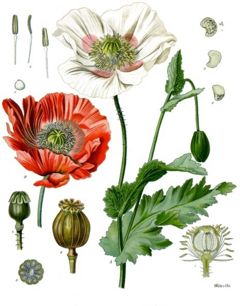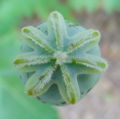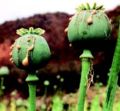Papaver somniferum: Difference between revisions
No edit summary |
No edit summary |
||
| (4 intermediate revisions by 2 users not shown) | |||
| Line 1: | Line 1: | ||
{{SPlantbox | |||
|familia=Papaveraceae | |||
|genus=Papaver | |||
|species=somniferum | |||
|common_name=Opium poppy | |||
|habit=herbaceous | |||
|Min ht box=90 | |||
|Min ht metric=cm | |||
|Max ht box=120 | |||
|Max ht metric=cm | |||
|Min wd box=30 | |||
|Min wd metric=cm | |||
|Max wd box=60 | |||
|Max wd metric=cm | |||
|origin=S.E. Europe, E Asia | |||
|lifespan=annual | |||
|exposure=sun, part-sun | |||
|water=moist, moderate | |||
|features=flowers, invasive, bees, cut flowers | |||
|flower_season=late spring, early summer, mid summer | |||
|flowers=red, orange, yellow, green, purple, multicolored, pink, white, single, double | |||
|Temp Metric=°F | |||
|min_zone=7 | |||
|max_zone=10 | |||
|image=Koeh-102.jpg | |||
|image_width=240 | |||
}} | |||
'''Opium poppy''', '''''Papaver somniferum var. album''''', is the [[species]] of [[plant]] from which [[opium]] and [[poppy seed]]s are extracted. Opium is the source of many [[opiate]]s, including [[morphine]], [[thebaine]], [[codeine]], [[papaverine]], and [[noscapine]]. The Latin botanical name means, loosely, the "sleep-bringing poppy, white form", referring to the [[narcotic]] property of some of these opiates. | |||
The poppy is the only species of [[Papaveraceae]] that is an [[agriculture|agricultural]] crop grown on a large scale. Other species, ''[[Papaver rhoeas]]'' and ''[[Papaver argemone]]'', are important agricultural weeds, and may be mistaken for the crop. | |||
The plant itself is also valuable for ornamental purposes, and has been known as the "common garden poppy", referencing all the group of poppy plants. | |||
Poppy seeds of ''Papaver somniferum'' are an important food item and the source of [[poppyseed oil]]. It is widely grown as an ornamental flower throughout Europe, North America, South America, and Asia. | |||
[[File:Poppy from above.JPG|thumb|right|A red opium poppy flower used for ornamental purposes]] | |||
Once known as the "common garden poppy", live plants and seeds of the opium poppy are widely sold by seed companies and nurseries in most of the western world, including the United States. Poppies are sought after by gardeners for the vivid coloration of the blooms, the hardiness and reliability of the poppy plants, the exotic chocolate-vegetal fragrance note of some cultivars, and the ease of growing the plants from purchased flats of seedlings or by direct sowing of the seed. Poppy seed pods are also sold for dried flower arrangements. | |||
It has been suggested that, since "opium poppy and poppy straw" are listed in Schedule II of the United States' [[Controlled Substances Act]], a [[DEA]] license may be required to grow poppies in ornamental or display gardens. In fact the legal status of strictly ornamental poppy gardens is more nuanced, with destruction of ornamental poppy installations or prosecution of gardeners (except those caught extracting opium via capsule scarification or tea extraction) virtually unheard of.<ref name=erowid /> During the early spring, opium poppies will be seen flowering in gardens throughout North America and Europe, with beautiful installations being found in many private planters, as well as public botanical and museum gardens (e.g. [http://www8.georgetown.edu/departments/physiology/cam/urbanherbs/urban_others.htm United States Botanical Garden], [http://www.eol.org/pages/594796 Missouri Botanical Garden], [http://www.flickr.com/photos/birdyboo/sets/72157605614393377/detail/ North Carolina Botanical Garden], [http://www.erowid.org/plants/show_image.php?i=poppy/papaver_somniferum8.jpg residential garden, Seattle, WA], and [http://local.floridata.com/Opium_Poppy_Hartford_CT-r1191238-Hartford_CT.html residential garden, Hartford, CT]). | |||
{{Inc| | {{Inc| | ||
Papaver somniferum, Linn. (P. opilferum, Forsk. P. nigrum, Crantz). Opium Poppy. Fig. 2751. Robust, glaucous and glabrous annual, 3-4 ft. high, with fls. 4-5 in. across, much larger than those of any annual | Papaver somniferum, Linn. (P. opilferum, Forsk. P. nigrum, Crantz). Opium Poppy. Fig. 2751. Robust, glaucous and glabrous annual, 3-4 ft. high, with fls. 4-5 in. across, much larger than those of any annual kind: lvs. oblong, unequally toothed at the base; st.-lvs. cordate at the base, sinuate-repand to dentate-serrate, very glaucous, clasping: fl.-bud ovoid-oblong, somewhat obtuse at apex, glabrous; petals orbiculate, entire, undulate or cut, from white through pink and red to purple, but not yellow or blue : caps, globose, glabrous, with a flat 8-12-lobed disk. Greece, Orient.— Sparingly run wild in N. Amer. Very variable in color of seeds, characters of caps., and form and color of petals. Var. album, DC. (P. officinale, Gmel.), has fls. and seeds white: caps, ovate-globose. | ||
kind: lvs. oblong, unequally toothed at the base; st.-lvs. cordate at the base, sinuate-repand to dentate-serrate, very glaucous, clasping: fl.-bud ovoid-oblong, somewhat obtuse at apex, glabrous; petals orbiculate, entire, undulate or cut, from white through pink and red to purple, but not yellow or blue : caps, globose, glabrous, with a flat 8-12-lobed disk. Greece, Orient | |||
Among the double horticultural forms of P. somniferum are two main strains or types, the carnation-fld. and the peony-fld. (the latter P. paeoniaeflorum, Hort.). The former has fringed petals; the latter not. Both include a wide range of color, and even a yellow form has been advertised, but this form is of doubtful authenticity. P. Mursellii is another strain of double fringed kinds, of which Mikado is a favorite. P. fim- briatum is another trade name for double fringed varieties. P. cardinale is the French name of another strain of double fringed fls. Chinese poppies are a double-fld. race intro. from Chinese gardens early in 1890, and comprising dwarfer strains than previously known. R.H. 1893, p. 349. An exceptionally interesting monstrosity has occurred in which there are no petals, and the stamens are supposed to be transformed into pistils which actually ripen seed. It was figured as long ago as 1851 in F.S. 6, p. 242, and again in R.H. 1893, p. 349. It seems to be no longer advertised, but it was considered to be constant. | Among the double horticultural forms of P. somniferum are two main strains or types, the carnation-fld. and the peony-fld. (the latter P. paeoniaeflorum, Hort.). The former has fringed petals; the latter not. Both include a wide range of color, and even a yellow form has been advertised, but this form is of doubtful authenticity. P. Mursellii is another strain of double fringed kinds, of which Mikado is a favorite. P. fim- briatum is another trade name for double fringed varieties. P. cardinale is the French name of another strain of double fringed fls. Chinese poppies are a double-fld. race intro. from Chinese gardens early in 1890, and comprising dwarfer strains than previously known. R.H. 1893, p. 349. An exceptionally interesting monstrosity has occurred in which there are no petals, and the stamens are supposed to be transformed into pistils which actually ripen seed. It was figured as long ago as 1851 in F.S. 6, p. 242, and again in R.H. 1893, p. 349. It seems to be no longer advertised, but it was considered to be constant. | ||
Among the single varieties, Danebrog is one of the most striking and popular. The white spots at the base of the petals form a cross. This variety is also known as Danish Cross, Danish Flag and Victorian Cross. Of the pure white kinds, Flag of Truce and The Bride are favorites. Mephisto is scarlet, spotted black. About a dozen other varieties are advertised by name. | Among the single varieties, Danebrog is one of the most striking and popular. The white spots at the base of the petals form a cross. This variety is also known as Danish Cross, Danish Flag and Victorian Cross. Of the pure white kinds, Flag of Truce and The Bride are favorites. Mephisto is scarlet, spotted black. About a dozen other varieties are advertised by name. | ||
{{SCH}} | |||
}} | }} | ||
==Cultivation== | |||
{{edit-cult}}<!--- Type cultivation info below this line, then delete this entire line --> | |||
===Propagation=== | |||
{{edit-prop}}<!--- Type propagation info below this line, then delete this entire line --> | |||
===Pests and diseases=== | |||
{{edit-pests}}<!--- Type pest/disease info below this line, then delete this entire line --> | |||
==Varieties== | |||
''Papaver somniferum'' has many sub-species or varieties and [[cultivar]]s. Colors of the [[flower]] vary widely, as do other physical characteristics such as number and shape of petals, number of flowers and fruits, number of seeds, color of seeds, production of morphine, etc. | |||
''Papaver somniferum'' Paeoniflorum Group (sometimes called ''Papaver paeoniflorum'') is a sub-type of opium poppy whose flowers are highly double, and are grown in many colors. ''Papaver somniferum'' Laciniatum Group (sometimes called ''Papaver laciniatum'') is a sub-type of opium poppy whose flowers are highly double and deeply lobed, to the point of looking like a ruffly [[pompon]]. | |||
A few of the varieties, notably the Norman and Przemko varieties, have low morphine content (less than one percent), but have much higher concentrations of other alkaloids. Most varieties, however, including those most popular for ornamental use or seed production, have a higher morphine content, with the average content being 10%. | |||
==Gallery== | |||
<gallery> | |||
Image:Illustration Papaver somniferum0.jpg|Opium Poppy <br /> from Thomé ''Flora von Deutschland, Österreich und der Schweiz'' 1885 | |||
Image:Field_of_opium.jpg|A field of opium poppy in Burma. | |||
Image:Opium_poppy.jpg|Ornamental poppy at [[Chatsworth House]], UK | |||
Image:Crowning_P_Somniferum_topview.jpg|Immature crowning opium poppy, top view | |||
Image:2poppies.jpg|Opium poppies | |||
Image:opium_harvest.jpg|Opium poppies during a harvest | |||
</gallery> | |||
==References== | |||
*[[Standard Cyclopedia of Horticulture]], by L. H. Bailey, MacMillan Co., 1963 | |||
<!--- xxxxx *Flora: The Gardener's Bible, by Sean Hogan. Global Book Publishing, 2003. ISBN 0881925381 --> | |||
<!--- xxxxx *American Horticultural Society: A-Z Encyclopedia of Garden Plants, by Christopher Brickell, Judith D. Zuk. 1996. ISBN 0789419432 --> | |||
<!--- xxxxx *Sunset National Garden Book. Sunset Books, Inc., 1997. ISBN 0376038608 --> | |||
==External links== | |||
*{{wplink}} | |||
{{stub}} | |||
[[Category:Categorize]] | |||
<!-- in order to add all the proper categories, go to http://www.plants.am/wiki/Plant_Categories and copy/paste the contents of the page here, and then follow the easy instructions! --> | |||
Latest revision as of 16:32, 4 February 2010
| Papaver somniferum subsp. var. | Opium poppy | |||||||||||||||||||||||||||||||||||||||||||||||||||||||
|---|---|---|---|---|---|---|---|---|---|---|---|---|---|---|---|---|---|---|---|---|---|---|---|---|---|---|---|---|---|---|---|---|---|---|---|---|---|---|---|---|---|---|---|---|---|---|---|---|---|---|---|---|---|---|---|---|

|
|
| ||||||||||||||||||||||||||||||||||||||||||||||||||||||
| ||||||||||||||||||||||||||||||||||||||||||||||||||||||||
Opium poppy, Papaver somniferum var. album, is the species of plant from which opium and poppy seeds are extracted. Opium is the source of many opiates, including morphine, thebaine, codeine, papaverine, and noscapine. The Latin botanical name means, loosely, the "sleep-bringing poppy, white form", referring to the narcotic property of some of these opiates.
The poppy is the only species of Papaveraceae that is an agricultural crop grown on a large scale. Other species, Papaver rhoeas and Papaver argemone, are important agricultural weeds, and may be mistaken for the crop.
The plant itself is also valuable for ornamental purposes, and has been known as the "common garden poppy", referencing all the group of poppy plants.
Poppy seeds of Papaver somniferum are an important food item and the source of poppyseed oil. It is widely grown as an ornamental flower throughout Europe, North America, South America, and Asia.

Once known as the "common garden poppy", live plants and seeds of the opium poppy are widely sold by seed companies and nurseries in most of the western world, including the United States. Poppies are sought after by gardeners for the vivid coloration of the blooms, the hardiness and reliability of the poppy plants, the exotic chocolate-vegetal fragrance note of some cultivars, and the ease of growing the plants from purchased flats of seedlings or by direct sowing of the seed. Poppy seed pods are also sold for dried flower arrangements.
It has been suggested that, since "opium poppy and poppy straw" are listed in Schedule II of the United States' Controlled Substances Act, a DEA license may be required to grow poppies in ornamental or display gardens. In fact the legal status of strictly ornamental poppy gardens is more nuanced, with destruction of ornamental poppy installations or prosecution of gardeners (except those caught extracting opium via capsule scarification or tea extraction) virtually unheard of.[1] During the early spring, opium poppies will be seen flowering in gardens throughout North America and Europe, with beautiful installations being found in many private planters, as well as public botanical and museum gardens (e.g. United States Botanical Garden, Missouri Botanical Garden, North Carolina Botanical Garden, residential garden, Seattle, WA, and residential garden, Hartford, CT).
| Standard Cyclopedia of Horticulture |
|---|
|
Papaver somniferum, Linn. (P. opilferum, Forsk. P. nigrum, Crantz). Opium Poppy. Fig. 2751. Robust, glaucous and glabrous annual, 3-4 ft. high, with fls. 4-5 in. across, much larger than those of any annual kind: lvs. oblong, unequally toothed at the base; st.-lvs. cordate at the base, sinuate-repand to dentate-serrate, very glaucous, clasping: fl.-bud ovoid-oblong, somewhat obtuse at apex, glabrous; petals orbiculate, entire, undulate or cut, from white through pink and red to purple, but not yellow or blue : caps, globose, glabrous, with a flat 8-12-lobed disk. Greece, Orient.— Sparingly run wild in N. Amer. Very variable in color of seeds, characters of caps., and form and color of petals. Var. album, DC. (P. officinale, Gmel.), has fls. and seeds white: caps, ovate-globose. Among the double horticultural forms of P. somniferum are two main strains or types, the carnation-fld. and the peony-fld. (the latter P. paeoniaeflorum, Hort.). The former has fringed petals; the latter not. Both include a wide range of color, and even a yellow form has been advertised, but this form is of doubtful authenticity. P. Mursellii is another strain of double fringed kinds, of which Mikado is a favorite. P. fim- briatum is another trade name for double fringed varieties. P. cardinale is the French name of another strain of double fringed fls. Chinese poppies are a double-fld. race intro. from Chinese gardens early in 1890, and comprising dwarfer strains than previously known. R.H. 1893, p. 349. An exceptionally interesting monstrosity has occurred in which there are no petals, and the stamens are supposed to be transformed into pistils which actually ripen seed. It was figured as long ago as 1851 in F.S. 6, p. 242, and again in R.H. 1893, p. 349. It seems to be no longer advertised, but it was considered to be constant. Among the single varieties, Danebrog is one of the most striking and popular. The white spots at the base of the petals form a cross. This variety is also known as Danish Cross, Danish Flag and Victorian Cross. Of the pure white kinds, Flag of Truce and The Bride are favorites. Mephisto is scarlet, spotted black. About a dozen other varieties are advertised by name. CH
|
Cultivation
- Do you have cultivation info on this plant? Edit this section!
Propagation
- Do you have propagation info on this plant? Edit this section!
Pests and diseases
- Do you have pest and disease info on this plant? Edit this section!
Varieties
Papaver somniferum has many sub-species or varieties and cultivars. Colors of the flower vary widely, as do other physical characteristics such as number and shape of petals, number of flowers and fruits, number of seeds, color of seeds, production of morphine, etc.
Papaver somniferum Paeoniflorum Group (sometimes called Papaver paeoniflorum) is a sub-type of opium poppy whose flowers are highly double, and are grown in many colors. Papaver somniferum Laciniatum Group (sometimes called Papaver laciniatum) is a sub-type of opium poppy whose flowers are highly double and deeply lobed, to the point of looking like a ruffly pompon.
A few of the varieties, notably the Norman and Przemko varieties, have low morphine content (less than one percent), but have much higher concentrations of other alkaloids. Most varieties, however, including those most popular for ornamental use or seed production, have a higher morphine content, with the average content being 10%.
Gallery
-
Opium Poppy
from Thomé Flora von Deutschland, Österreich und der Schweiz 1885 -
A field of opium poppy in Burma.
-
Ornamental poppy at Chatsworth House, UK
-
Immature crowning opium poppy, top view
-
Opium poppies
-
Opium poppies during a harvest
References
- Standard Cyclopedia of Horticulture, by L. H. Bailey, MacMillan Co., 1963
External links
- w:Papaver somniferum. Some of the material on this page may be from Wikipedia, under the Creative Commons license.
- Papaver somniferum QR Code (Size 50, 100, 200, 500)
- ↑ Cite error: Invalid
<ref>tag; no text was provided for refs namederowid





